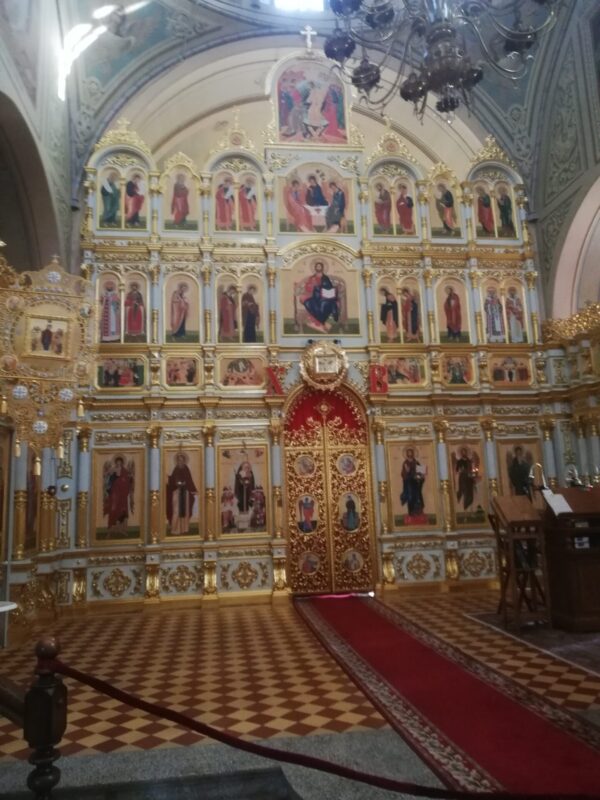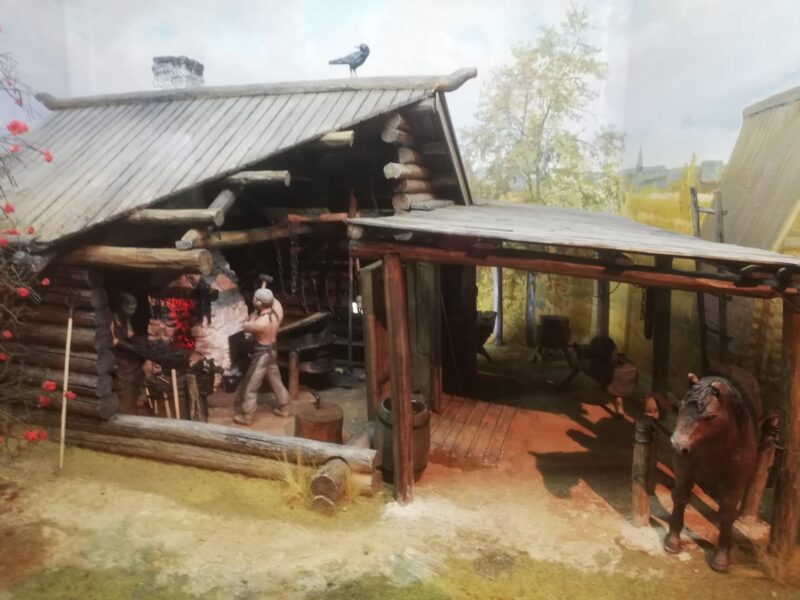An advantage of sleeping in the van is that we were up and in the village before practically anybody else. We went to see the Cathedral of the Icon of the Mother of all who Sorrow (a nunnery) just as a stream of nuns came out, average age about 110, apart from Anastasiya. She was perhaps in her late thirties and very jolly. Delighted to know that we were from Britain, telling us that “Russia loves everybody”, and she wanted my phone number. She gave us a couple of books about the Cathedral as well as some postcards and 2025 calenders. The cathedral is probably the newest building in the village, built in 1898-1906. The paintings were created with money donated by a merchant from Yelabug.
We then went to see the Temple of St.Sergius Radonezh, erected in 1570-1604 on the site of an earlier wooden church built on the orders of Ivan the Terrible in 1551 when Svyazhskoye was founded as a fort. It was interesting to see that the church is located on the second floor of the building and has the most beautiful paintings. At the entrance there is a fresco dating from when the church was built. The first floor consists of “services and household premises”. There was a small wooden church nearby which was supposed to open at 10.00 but didn’t, so we didn’t get to see inside.
We then walked up the main strret and found a tiny restaurant “Khachapuri” run by a very pleasant Georgian lady who cooked some delicious khachapuris for us. Consisting of cheese enclosed in pastry, it is the national dish of Georgia. There are huge numbers of Georgians in Russia (and Russians in Georgia), with every city having at least one khachapuri restaurant.
We finally walked back to the entrance, passing a garden with apple trees which are decendants of the apple trees brought from Lev Tolstoy’s estate. Tolstoy spent his childood in Kazan (and studied at its university) and was a frequent visitor to Svyazhskoye. A visit to the museum of the history of Svyazhskoye proved far more interesting than expected. It is quite sophisticated with a number of short films and models of people from the time the village was created and scenes of daily life in the 16th century. There was a separate building dealing with “the jail of Svyazhskoye” with gruesome details of the punishments meted out to transgressors at the time of Ivan the Terrible. Folks who fell foul of the church were burned while conterfeiters had molten iron poured down their throats.
Finally we went to see the ensemble of buildings at the entrance to Svyazhskoye. The first destination was the museum and shop to buy a bottle of home-made lemonade, Then we went to see the Church built in honour of Nikolai Chudotvorets in 1556, beneath which we saw the cell of St Herman who was responsible for building the church. The Cathedral in Honour of Uspeniye Presvyatoi Bogoroditsii, (aka Cathedral in Honour of the Assumption of the Blessed Virgin Mary) built in 1560 with beautiful 16th century frescoes was closed until 3 pm and we needed tickets so, sadly, we didn’t get to see it. The Cathedral in honour of Saint Herman built in 1799 had some nice pictures but wasn’t particularly memorable. So we went to see the Ascension Church at the entrance to the complex. It was built in 1799. We didn’t see a single cat, which is odd because Raifa monastery was inundated with them; we saw 11 at one point, all very tame and wanting to be stroked. By this time we were pretty tired and churched-out so we went back to the van and set off for Nizhnii Novgorod. About 6 pm we found a service station and had a very nice meal. I had what Russians call “goulash” which is chunks of chicken in sauce eaten with rice while Jennifer had a large slice of pork coated in a mixture of eggs, onions and various sauces like a pancake. We spent the night there.






















